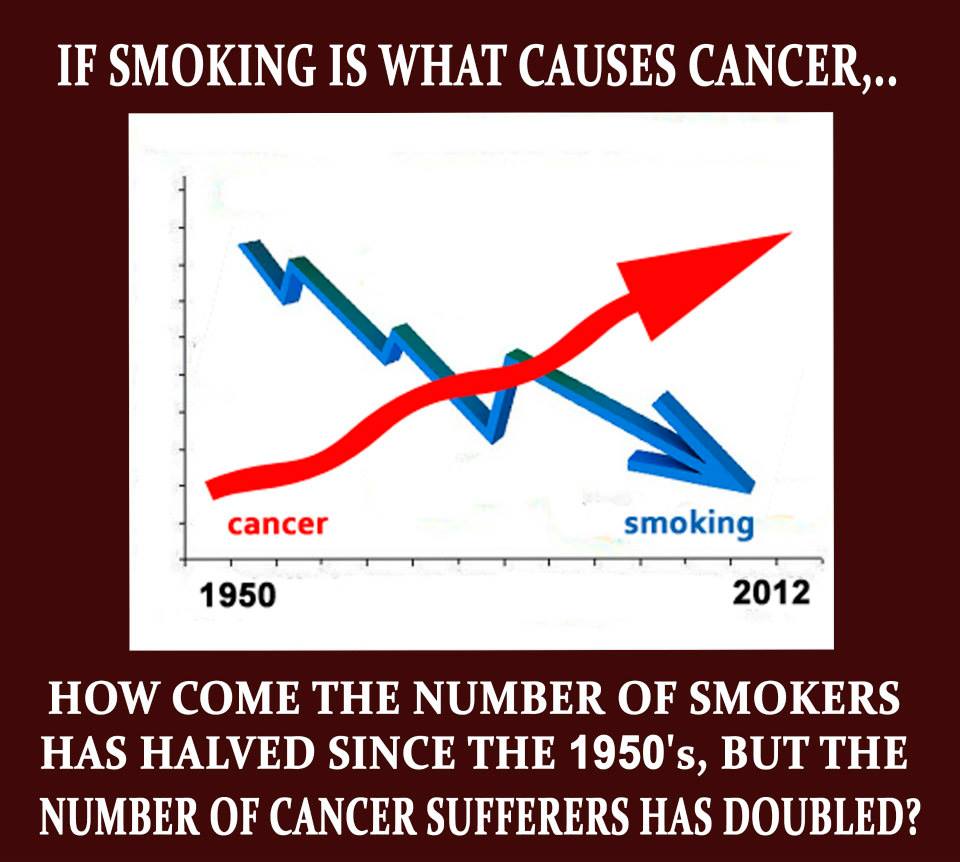
Smoking is a cause of liver cancer and colorectal cancer, the fourth-most-diagnosed form of the disease in the United States, Acting Surgeon General Boris D. Lushniak found in a report released Friday. In addition, he said, smoking is a cause of Type 2 diabetes mellitus, age-related macular degeneration, erectile dysfunction and rheumatoid arthritis. It can impair the immune system, worsen asthma and cause cleft lips and palates in fetuses. And exposure to secondhand smoke can cause strokes.
Smokers today have a much higher risk of developing lung cancers than did smokers in the 1960s, probably because of changes in the design and composition of cigarettes over time, according to the findings.
Comment: So this has nothing to do with our poisoned environment? 'The tobacco industry' seems to be an easy scapegoat, but isn't it more likely that the increase in rates of cancers of ALL kinds isn't due to this one factor, smoking? Colorectal cancer? Diabetes mellitus? Erectile dysfunction? Seriously? Pick an ailment and apparently the U.S. Surgeon General can pin it on smoking...
Air pollution causes lung cancer in non-smokers (erm, can't it cause it in smokers too then?)
Friday's report, the latest of more than 30 such documents issued by surgeons general since the landmark 1964 examination of smoking's health consequences, offered another round of evidence of tobacco's potential to harm nearly every human organ.
"The conclusions from these reports have evolved from a few causal associations in 1964 to a robust body of evidence documenting health consequences both from active smoking and exposure to secondhand smoke across a range of diseases and organ systems,"Lushniak wrote of the findings. "A half century after the release of the first report, we continue to add to the long list of diseases caused by tobacco use and exposure."
There's little doubt that the decades of public health efforts to educate Americans about the dangers of smoking, as well as a sustained push for tighter tobacco controls, have produced tangible results.
Cigarette smoking has continued to decline among adults, from 42 percent in 1965 to 18 percent in 2012. The United States now has more former smokers than current smokers.
All told, anti-smoking measures have spared an estimated 8 million lives in the country over the past 50 years and contributed to longer life expectancies, according to a study released last week by the Journal of the American Medical Association. A far-reaching law enacted in 2009 also gave the Food and Drug Administration the power to regulate cigarettes and other tobacco products for the first time.
Yet, as Friday's report makes clear, the human and economic damage from smoking persists.
Since 1964, more than 20 million Americans have died prematurely from smoking, and tobacco use remains the leading cause of preventable death in the United States. The Centers for Disease Control and Prevention estimates that 443,000 Americans die each year from smoking-related illnesses, and each day, thousands of teenagers try their first cigarette.
Comment: Lies, Damned Lies & 400,000 Smoking-related Deaths: Cooking the Data in the Fascists' Anti-Smoking Crusade
[...] the U.S. Surgeon General's 1989 report estimated that 335,600 deaths were caused by smoking. When Sterling, Rosenbaum, and Weinkam recalculated the Surgeon General's numbers, replacing the distorted CPS sample with a more representative baseline from large surveys conducted by the National Center for Health Statistics, they found that the number of smoking-related deaths declined to 203,200. Thus, the Surgeon General's report overstated the number of deaths by more than 65 percent simply by choosing the wrong standard of comparison.
Sterling and his coauthors report that not only is the death rate considerably lower for the CPS sample than for the entire U.S. but, astonishingly, even smokers in the CPS sample have a lower death rate than the national average for both smokers and nonsmokers. As a result, if OTA were to have used the CPS death rate for smokers, applied that rate to the total population, then subtracted the actual number of deaths for all Americans, it would have found that smoking saves 277,621 lives each year.
In addition, the direct medical costs of smoking add up to more than $130 billion per year, along with $150 billion a year in productivity losses from premature deaths, according to Friday's report.
Last week, a collection of public health and anti-tobacco groups, including the American Academy of Pediatrics and the American Heart Association, collectively called for a "new national commitment" to eliminating tobacco-related deaths. Among their suggestions: tobacco tax increases, broader laws for smoke-free workplaces, strict tobacco oversight from the FDA, and aggressive advertising campaigns to help smokers quit and keep nonsmokers from lighting up.
"It's a winnable fight," said Matthew Myers, president of the Campaign for Tobacco-Free Kids. "We actually have the policies and programs to end the tobacco epidemic, and they don't cost so much they can't be implemented quickly."
Friday's surgeon general report supports those actions and others, even as it notes that "the current rate of progress in tobacco control is not fast enough." It cites significant public-health victories in the past, such as the eradication of smallpox and polio, saying that the elimination of tobacco-related death and disease deserves a similar level of commitment from every corner of society.




Studies that show health benefits of Nicotine do NOT prove that SMOKING IT is good for you in ANY WAY. Smoking is not the only way to introduce the chemical effects of nicotine into the body.
Seriously, this is just trying way too hard. Half of the links in the blue boxes are a bunch of BS too. Sometimes I think that the editors here will just post any article that contradicts popular opinion, no matter how much sense it actually makes.